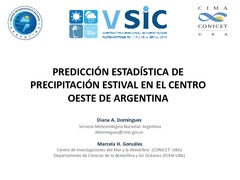Mostrar el registro sencillo del ítem
Predicción estadística de precipitación estival en el centro oeste de Argentina
| dc.contributor.author | Domínguez, Diana Analía | |
| dc.contributor.author | González, Marcela Hebe | |
| dc.date.accessioned | 2017-11-13T12:36:01Z | |
| dc.date.available | 2017-11-13T12:36:01Z | |
| dc.date.issued | 2013-09 | |
| dc.identifier.uri | http://hdl.handle.net/20.500.12160/555 | |
| dc.description | Trabajo presentado en el V Simpósio Internacional de Climatologia (V SIC) realizado desde el 15 al 19 de septiembre de 2013, por la Sociedade Brasileira de Meteorologia (SBMET) en Santa Catarina, Brasil. | es |
| dc.description.abstract | Este trabajo intenta entender la variabilidad de la precipitación y para luego poder predecirla en escala estacional. Se estudió el comportamiento de la precipitación de verano (Diciembre, Enero y Febrero) en una región del centro oeste argentino basándose en la comparación del comportamiento de las variables atmosféricas y oceánicas en años con sequía y con exceso de precipitación. Se investigó la existencia de predictores de las situaciones de lluvia en el mes de noviembre. La región se subdividió en tres sub-regiones debido a la heterogeneidad del régimen de lluvia. La altura geopotencial fue la variable que discriminó mejor los distintos casos. El calentamiento del Océano Pacífico central fue otro factor relacionado con la precipitación en toda la región. En general los casos de mayor precipitación estuvieron asociados al debilitamiento de las altas subtropicales y las bajas subpolares, es decir un debilitamiento del flujo zonal y por lo tanto un mayor intercambio de energía entre bajas y altas latitudes ya anomalías cálidas de temperatura de superficie del mar en noviembre en el Pacífico ecuatorial oriental. Este análisis permitió definir, para cada grupo, predictores que se utilizaron para generar un modelo de regresión lineal múltiple utilizando la metodología forward stepwise. Los resultados indicaron que la altura geopotencial de 1000 hpa y la temperatura de superficie del mar del Océano Pacífico central son los mejores predictores explicando, en cada sub-región el 43%, 28% y 16% de varianza de la serie de precipitación de verano respectivamente de Este a Oeste. Esto da cuenta de la pérdida de predictibilidad en las regiones ubicadas más hacia el Oeste. El modelo se validó utilizando la técnica de crossvalidación. | es |
| dc.description.abstract | This paper attempts to understand the variability of precipitation and then to predict seasonal scale. We studied the behavior of summer precipitation (December, January and February) in a region of west central Argentina based on comparing the behavior of atmospheric and oceanic variables in years with drought and excess precipitation. We investigated the existence of situations predictors of rain in the month of November. The region is subdivided into three sub-regions due to the heterogeneity of the rainfall regime. Geopotential height was the variable that best discriminated the different cases. The warming of the central Pacific Ocean was another factor related to the precipitation across the region. Generally higher precipitation cases were associated with the weakening of the subtropical high and subpolar low, ie a weakening of zonal flow and therefore greater energy exchange between low and high latitudes and warm anomalies of sea surface temperature in November in the eastern equatorial Pacific. This analysis allowed us to define, for each group, predictors that were used to generate a multiple linear regression model using forward stepwise methodology. The results indicated that the 1000 hPa geopotential height and sea surface temperature in the central Pacific Ocean are the best predictors explaining, in each sub-region 43%, 28% and 16% of variance of the series of summer precipitation respectively from east to west. This accounts for the loss of predictability in the regions located further west. The model was validated using crossvalidación technique. | en |
| dc.language.iso | spa | es |
| dc.publisher | Sociedade Brasileira de Meteorologia | es |
| dc.title | Predicción estadística de precipitación estival en el centro oeste de Argentina | es |
| dc.type | Presentation | es |
| dcterms.subject | PRECIPITACIÓN | |
| dcterms.subject | PRONÓSTICO ESTADÍSTICO | |
| dcterms.subject | ARGENTINA CENTRAL | |
| dcterms.subject | TEMPERATURA DE SUPERFICIE DEL MAR |
